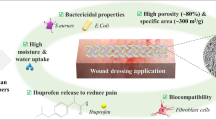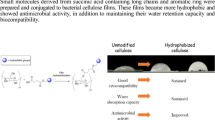Abstract
Wound dressing plays an important role in maintaining a moist environment and facilitating proper wound healing. This study focuses on the development of water-insoluble expandable carboxymethyl cellulose (CMC)–alginate foam for cavity dressing applications. CMC is widely used in the medical field due to its excellent absorbency, biocompatibility and ability to promote wound healing. However, CMC lacks mechanical properties and shape stability in moist environment. The effects of CMC solution concentration, heat treatment temperature, and addition of alginate on the water absorption, water retention performance, and physical properties of the foam were evaluated. The results indicate that higher CMC solution concentrations led to increased weight and density, improved structural integrity, and enhanced wet compressive strength but prolonged absorption time. Heat treatment with citric acid as a cross-linking agent resulted in increased wet compressive strength and decreased absorption time. Additionally, the incorporation of alginate influenced the absorption properties and compressive strengths of the foam. The study confirms the potential usability of CMC–alginate freeze-dried foam for cavity dressing applications, providing insights for further research in this area.















Similar content being viewed by others
Data Availability
The data supporting the findings of this study are available from the corresponding author upon reasonable request.
References
M.E. Okur, I.D. Karantas, Z. Şenyiğit, N.Ü. Okur, P.I. Siafaka, Asian. J. Pharm. Sci. 15(6), 661 (2020)
S. Baranoski, E.A. Ayello, Wound Care Essentials: Practice Principles, 2nd edn. (Lippincott Williams & Wilkins, 2008), pp. 2–4
J. Lei, L. Sun, P. Li, C. Zhu, Z. Lin, V. Mackey, D.H. Coy, Q. He, Health Sci. J. 13(4), 1 (2019)
E.R. Ghomi, S. Khalili, S.N. Khorasani, R.E. Neisiany, S. Ramakrishna, J. Appl. Polym. Sci. 136(27), 47738 (2019)
C. Zhang, S. Zhang, B. Wu, K. Zou, H. Chen, Nurs. Open 10, 5857 (2023)
T. Abdelrahman, H. Newton, Surgery (oxf). 29(10), 491 (2011)
K.J.B. Kus, E.S. Ruiz, Curr. Dermatol. Rep. 9, 298 (2020)
P.I. Morgado, A.A. guiar-Ricardo, I.J. Correia, J. Membr. Sci. 490, 139 (2015)
H.H. Han, D.Y. Oh, J Korean Med Assoc. 58(9), 809 (2015)
R. Pudner, J. Community Nurs. 12, 22 (1998)
K.C. Broussard, J.G. Powers, Am. J. Clin. Dermatol. 14(6), 449 (2013)
J. Nielsen, K. Fogh., Chronic Wound Care Manag. Res. 2, 31 (2015)
F. Dinah, A. Adhikari, Ann. R. Coll. Surg. Engl. 88(1), 33 (2006)
M. H. Park, S. C. Lee, S. A. Kang, U.S. Patent No. 7,777,090 (2010)
V. Kanikireddy, K. Varaprasad, T. Jayaramudu, C. Karthikeyan, R. Sadiku, Int. J. Biol. Macromol. 164, 963 (2020)
N. Reddy, R. Reddy, Q. Jiang, Trends Biotechnol. 33(6), 362 (2015)
K.K. Mali, S.C. Dhawale, N.S. Dhane, Indian J. Pharm. Sci. 80(4), 657 (2018)
B. Sheokand, M. Vats, A. Kumar, C.M. Srivastava, I. Bahadur, J. Polym. Sci. 61(14), 1389 (2023)
K. Varaprasad, T. Jayaramudu, V. Kanikireddt, C. Toro, E.R. Sadiku, Carbohydr. Polym. 236, 116025 (2020)
W. Zheng, C. Chen, X. Zhang, X. Wen, Y. Xiao, L. Li, Q. Xu, F. Fu, H. Diao, X. Liu, Surf. Coat. Technol. Surf Coat Tech. 406, 126644 (2021)
J. Cui, J. Varma, T. Emrick, C. Bien, D. Preda, D. Gamliel, J. Mater. Sci. 58(19), 8230 (2023)
M.S. Rahman, M.S. Hasan, A.S. Nitai, S. Nam, A.K. Karmakar, M.S. Ahsan, M.J.A. Shiddiky, M.B. Ahmed, Polym. 13, 1345 (2021)
N.S.V. Capanema, A.A.P. Mansur, A.C. de Jesus, S.M. Carvalho, L.C. de Oliveira, H.S. Mansur, Int. J. Biol. Macromol. 106, 1218 (2018)
H. Huang, H. Chen, X. Wang, F. Qiu, H. Liu, ACS Biomater. Sci. Eng. 5(10), 5498 (2019)
W. J. Cho, S. H. Oh, J. H. Lee., J. Biomater. Sci. Polym. Ed. 21(6), 701 (2010)
V. Hegde, U.T. Uthappa, T. Altalhi, H.Y. Jung, S.S. Han, M.D. Kurkuri, Mater. Today Commun. 33, 104813 (2022)
N. Reddy, Y. Yang, Food Chem. 118(3), 702 (2010)
C. Demitri, R.D. Sole, F. Scalera, A. Sannino, G. Vasapollo, A. Maffezzoli, L. Ambrosio, G. Vasapollo, A. Maffezzoli, L. Ambrosio, L. Nicolais, J. Appl. Polym. Sci. 110(4), 2453 (2008)
M.S. Birajdar, H. Joo, W.G. Koh, H. Park, Biomater. Res. 25(1), 1 (2021)
J.E. Gough, C.A. Scotchford, S.D. Gough, J. Biomed. Mater. Res. 61(1), 121 (2002)
S. Nangare, Y. Vispute, R. Tade, S. Dugam, P. Patil, Future J. Pharm. Sci. 7(1), 1 (2021)
D.Y. Lee, C. Chun, S. Son, Y. Kim, J. Korean Cryst. Growth Cryst. Technol. 32(3), 107 (2022)
W.J. Zheng, J. Gao, Z. Wei, J. Zhou, Y.M. Chen, Eur. Polym. J. 72, 514 (2015)
M.J. Waring, D. Parsons, Biomater. 22(9), 903 (2001)
Acknowledgements
This work was supported by the Korea Institute of Industrial Technology under “Development of fiber-based technology for reduction of hazardous substances in the air” [grant number KITECH EO-24-0004].
Funding
Korea Institute of Industrial Technology, EO-24-0004.
Author information
Authors and Affiliations
Corresponding author
Ethics declarations
Conflict of Interest
The authors declare that there is no conflict of interest.
Rights and permissions
Springer Nature or its licensor (e.g. a society or other partner) holds exclusive rights to this article under a publishing agreement with the author(s) or other rightsholder(s); author self-archiving of the accepted manuscript version of this article is solely governed by the terms of such publishing agreement and applicable law.
About this article
Cite this article
Kim, Y., Lee, G.D., Im, J.N. et al. Optimization of Water-Insoluble Carboxymethyl Cellulose Foam for Wound Dressing Materials. Fibers Polym 25, 1975–1983 (2024). https://doi.org/10.1007/s12221-024-00573-w
Received:
Revised:
Accepted:
Published:
Issue Date:
DOI: https://doi.org/10.1007/s12221-024-00573-w




